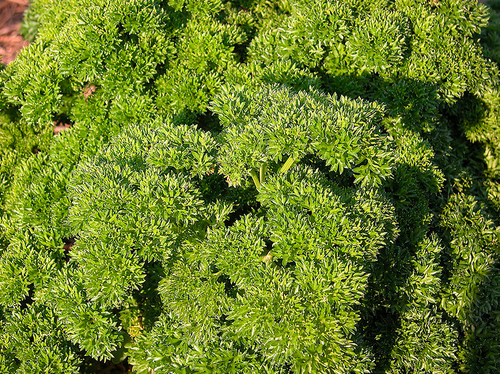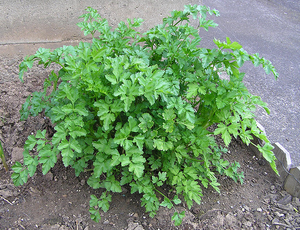
Parsley (Petroselinum crispum and other varieties) is a biennial herb most often grown as an annual. It is probably the best known of all the herbs, given its wide use and pleasant flavour.
Parsley is a native of the Mediterranean region and has been favoured for cuisine and medicinal purposes since at least the time of the Ancient Greeks.
Varieties of parsley[edit | edit source]

There are a few varieties of parsley. The most commonly known one is the flat-leaved curly variety. There is also Italian parsley (P. crispum var. Neapolitanum) and a turnip rooted or Hamburg parsley (P. crispum var. Tuberosum). The latter two are less used, although Italian parsley has gained in popularity recently. The turnip rooted parsley has a delicately flavoured root.
All three types tend to be used in the same way. Note that flat leaf varieties tend to taste stronger.
Growing parsley[edit | edit source]
- Sow parsley seeds direct into garden beds between spring and autumn. Alternatively, use seedlings. Seeds can take up five to eight weeks to germinate. Seeds can be sown in succession through summer for repeat crops.
- Given the long time for germination, consider planting indoors, then transplanting the seedlings. However, you may experience problems with transplanting, so experiment.
- Soaking the seeds may help to speed up germination and is recommended by many parsley growers.
- Choose a suitable spot. Parsley likes a moist, well-drained soil of moderate richness. Parsley can grow in sun or half-shade.
- Thin seedlings to 8cm (3 inches) apart and later to 20cm (8 inches) apart. Parsley plants grow best when not touching each other.
- Weed regularly. Protect from winter frosts.
- Expect flowers only in the spring of the second year.
If growing in pots, use deep containers or tubs. Parsley tends to grow well in pots, making it ideal for the indoor or back door kitchen herb garden. Parsley grown indoors does not tend to thrive as well as parsley grown outdoors.
Lime may be needed in soil that is extremely acidic.
Harvesting and storing parsley[edit | edit source]
Pick leaves from the outside of the parsley plant when harvesting. New leaves grow from the centre of the crown.
Freeze in ice cube trays for best flavour; dried parsley quickly loses its flavour.
Roots can be collected in the second season and dried.
Using parsley for culinary purposes[edit | edit source]
Parsley has many uses in cooking and as a food garnish. Typical uses include:
- Egg dishes.
- Soups.
- Sauces and marinades.
- Salads.
- Add a sprig as garnish to any main course dish.
- Use in bouquet garni.
Medicinal uses of parsley[edit | edit source]
Parsley has healing properties.[verification needed] It can be used crushed or as a juice in poultices or lotions to heal skin conditions. It can be used to reduce allergic reactions. Parsley is rich in vitamins C and A and minerals essential to the human body (e.g., iron, magnesium and calcium). Other medicinal uses include:[verification needed]
- Treating menstrual cramps.
- Treating bladder inflammation.
Avoid medicinal use during pregnancy as it has a stimulating effect on the uterus. However, after pregnancy it can help to stimulate milk flow. It should also be avoided if you have a kidney disease or infection.[1]
Sources and citations[edit | edit source]
- ↑ Rachel Corby, The Medicine Garden, p. 36, (2009)